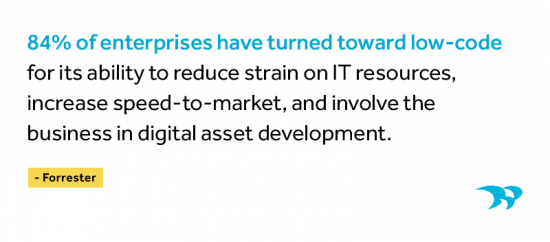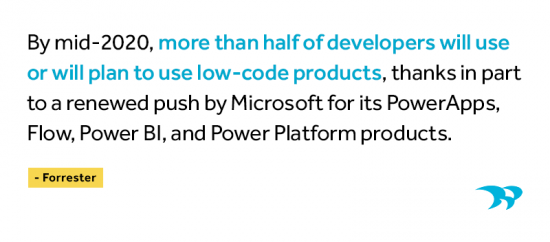|
Getting your Trinity Audio player ready...
|
Low code development platforms are touted as tools to help nimble businesses accelerate the deployment of applications to rapidly transform their business.
Definition: Low Code Development Platforms are “products and/or cloud services for application development that employ visual, declarative techniques instead of programming.” Forrester
What exactly does that mean? Think of it this way: When you’re using Excel you don’t need to know how to code to tell the application to add, multiply, subtract or divide values. You simply click the function key to tell the software what you want to do. You’re giving the software instructions without having to write any program code.
 Low code/no code development works in a similar way. In theory, anyone can build an application by using the platform’s building blocks and providing instructions for what they want it to do, without specifying exactly how to do it.
Low code/no code development works in a similar way. In theory, anyone can build an application by using the platform’s building blocks and providing instructions for what they want it to do, without specifying exactly how to do it.
Since low code platforms don’t require traditional programming expertise, business units and employees outside of traditional IT departments can now build and deliver the customized business applications they need and want. It’s contributing to the rise of the “citizen developer”, which can be a double-edged sword.
Definition: Citizen developers are users who create new business applications for consumption by themselves or others using low-code development platforms provided by corporate IT. Gartner
Citizen developers allow companies to extend resources – which is good news given the current skills shortage in IT – but it can present risks to business if IT experts and departments aren’t working closely with these emerging citizen developers.
While low code and no code platforms are hailed as simple to configure and deploy, IT and software experts have a critical role in making sure these solutions are created, documented and deployed properly and securely.
Pros and Cons of Low Code Development
There’s no doubt low code platforms (like Microsoft’s Power Platform), can help bridge the gap between software needs and manpower; but before companies dive deep into deploying low code solutions across their organization there are a few things to consider.
1. You’re Moving to the Cloud
You can’t have a low code/no code discussion without talking about Cloud and Software-as-a-Service (SaaS) solutions. As we discussed in our application modernization guide, looking at cloud-based solutions is a very important consideration when looking at updating legacy applications.
One of the major advantages to the cloud-based SaaS solutions like the Microsoft Power Platform is that it eliminates the complexity of managing hardware and keeping systems up to date.
Businesses can focus on configuring solutions to meet business needs, instead of worrying about the complexities of the “plumbing” underneath.

2. It’s Not Really DIY Applications
While the interfaces are definitely more user-friendly, and they are lauded as solutions that are easy for the citizen developer to deploy, configuring and customizing low code platforms isn’t as easy as it may seem and, if not handled properly, can present business risks.
- Rights and Security – Does the average citizen developer know who really needs access to specific information at specific times in a workflow? Thinking about and then limiting access rights to the right people at the right time is required for every solution. When it comes to SharePoint deployments, access rights are also critical to maintaining privacy and security and it’s something we’ve helped numerous clients address.
- Data Accuracy – When configuring reports, if you aren’t selecting and filtering out the right information, your analysis will be flawed or worse, you could be generating informational outputs that are completely incorrect. We worked with clients who didn’t realize test data was included in their output reports, rending the data meaningless.
- Scalability – Tools can work great when they’re used by a small group, but you need to make sure they’ve been built to handle the demands of the entire company. With careful planning at the outset you can make sure solutions have the resilience and scalability you need.
- Documentation & Ownership – If a citizen developer builds an app then leaves the company, their account is typically deleted or disabled and their app can stop working. They probably never documented how that app was designed, built and used, leaving the rest of your team unable to function properly. We’ve encountered this issue many times with clients, which is why detailed documentation and knowledge transfer is built into our work plans.
3. Different Skills Required
For a traditional software developer, generally 20% of their skillset is requirements analysis and understanding business functionality needs and 80% is understanding tools and technology.
That split is typically reversed for low code platform experts: 80% of their skillset is being able to work directly with clients and end users, taking them through a process of articulating and understanding their requirements, and 20% is expertise in configuring the technical tools.
When deploying a low code platform, you need to make sure you’ve got the right skills and expertise in place.

4. There Are Limits
These new low code platforms are very powerful and have some incredible functionality, but there are limits to their flexibility and their ability to be adapted to meet very specific business requirements. There are applications and business situations where fully custom software solutions will be a better fit in the long run.
Making the decision between using off-the-shelf and custom software requires careful analysis. You need to weigh many different factors including functionality fit, process alignment and unique application requirements against your business goals and priorities to make the best decision for your unique circumstances.
Avoid Creating a Monster
So, are low code and no code applications right for your business? There are some very clear and compelling benefits such as speed and ease of deployment, lower costs to configure and customize when compared to custom software, and they are built to reduce dependence on IT resources. But you must weigh these against the potential pitfalls when deciding if a low code platform makes sense for your business.
Before making a decision, take the time to conduct a detailed needs analysis so you can make sure the solution you choose is the best fit for your business today and in the future. If you determine a low code platform is right for you, it’s still a good idea to enlist the help of an experienced software development partner. While these applications are more user-friendly, you might end up with Frankenstein’s monster if you’re not sure what you’re doing.
We’ve seen it happen time and again where companies get excited about deploying new solutions and users across an organization, start building solutions to meet niche needs, and it all works well for a short period of time, then falls apart.
Within a few short months or a year, these solutions start to break down, or there are so many rogue, disconnected applications that a company can’t operate effectively. That’s when we get the call to fix the problems. You’ll spare yourself a lot of future headaches by getting help from the outset.
Considering a low code development platform and need help? Let’s talk.
